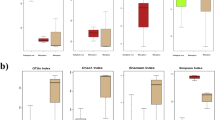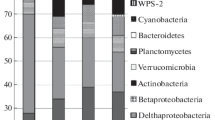Abstract
Molecular techniques were used to characterize bacterial community structure, diversity (16S rDNA), and activity (16S rRNA) in rhizospheres of three grain legumes: faba beans (Vicia faba L., cv. Scirocco), peas (Pisum sativum L., cv. Duel) and white lupin (Lupinus albus L., cv. Amiga). All plants were grown in the same soil under controlled conditions in a greenhouse and sampled after fruiting. Amplified 16S rDNA and rRNA products (using universal bacterial primers) were resolved by denaturing gradient gel electrophoresis (DGGE). Distinct profiles were observed for the three legumes with most of the bands derived from RNA being a subset of those derived from DNA. Comparing the total bacterial profiles with actinomycete-specific ones (using actinomycete-specific primers) highlighted the dominance of this group in the three rhizospheres. 16S PCR and RT-PCR products were cloned to construct libraries and 100 clones from each library were sequenced. Actinomycetes and proteobacteria dominated the clone libraries with differences in the groups of proteobacteria. Absence of β-subdivision members in pea and γ-subdivision members of proteobacteria in faba bean rhizosphere was observed. Plant-dependent rhizosphere effects were evident from significant differences in the bacterial community structure of the legume rhizospheres under study. The study gives a detailed picture of both residing and „active” bacterial community in the three rhizospheres. The high abundance of actinomycetes in the rhizospheres of mature legumes indicates their possible role in soil enrichment after the legumes are plowed into the soil as biofertilizers.






Similar content being viewed by others
References
EF Abd-Allah (2001) ArticleTitleStreptomyces plicatus as a model biocontrol agent Folia Microbiol (Praha) 46 309–314
ES Abrams VP Stanton (1992) ArticleTitleUse of denaturing gradient gel electrophoresis to study conformational transitions in nucleic acids Methods Enzymol 212 71–104
BM Duineveld GA Kowalchuk A Keijzer JD Elsas ParticleVan JA Veen ParticleVan (2001) ArticleTitleAnalysis of bacterial communities in the rhizosphere of chrysanthemum via denaturing gradient gel electrophoresis of PCR-amplified 16S rRNA as well as DNA fragments coding for 16S rRNA Appl Environ Microbiol 67 172–178
A Felske A Wolterink R Lis ParticleVan ADL Akkermans (1998) ArticleTitlePhylogeny of the main bacterial 16S rRNA sequences in Drenste A grassland soils (The Netherlands) Appl Environ Microbiol 64 871–879
RC Foster (1988) ArticleTitleMicroenvironments of soil microorganisms Biol Fertil Soils 6 189–203
SM Gathumbi JK Ndufa KE Giller G Cadisch (2002) ArticleTitleDo mixed species improved fallows increase above- and below-ground resources capture? Agron J 94 518–526
K Getha S Vikineswary (2002) ArticleTitleAntagonistic effects of Streptomyces violaceusniger strain G10 on Fusarium oxysporum f.sp.cubense race 4: indirect evidence for the role of antibiosis in the antagonistic process J Ind Microbiol Biot 28 303–310
NCM Gomes H Heuer J Schönfeld R Costa L Hagler-Mendonca K Smalla (2001) ArticleTitleBacterial diversity of the rhizosphere of maize (Zea mays) grown in tropical soil studied by temperature gradient gel electrophoresis Plant Soil 232 167–180
RC Gomes LT Semedo RM Soares CS Alviano LF Linhares RR Coelho (2000) ArticleTitleChitinolytic activity of actinomycetes from a cerrado soil and their potential in biocontrol Lett Appl Microbiol 30 146–150
BS Griffiths K Ritz N Ebblewhite G Dobson (1999) ArticleTitleSoil microbial community structure: effects of substrate loading rates Soil Biol Biochem 31 145–153
RI Griffiths AS Whiteley AG O’Donnell MJ Bailey (2000) ArticleTitleRapid method for co-extraction of DNA and RNA from natural environments for analysis of ribosomal DNA- and rRNA-based microbial community composition Appl Environ Microbiol 66 5488–5491
RJ Haynes RJ Martin KM Goh (1993) ArticleTitleNitrogen fixation, accumulation of soil nitrogen and nitrogen balance for some field-grown legume crops Field Crop Res 35 85–92
H Heuer K Smalla (1997) Application of denaturing gradient gel electrophoresis and temperature gradient gel electrophoresis for studying soil microbial communities JD Elsas ParticleVan JT Trevors EMH Wellington (Eds) Modern Soil Microbiology Marcel Dekker New York 353–373
J Heukeshoven R Dernick (1986) Neue Ergebnisse zum Mechanismus der Silberfärbung BJ Radola (Eds) Electrophorese Forum’86 Technische Universität München Munich 22–27
RK Hynes DC Jans E Bremer NZ Lupwayi WA Rice GW Clayton MM Collins (2001) ArticleTitleRhizobium population dynamics in the pea rhizosphere of rhizobial inoculant strain applied in different formulations Can J Microbiol 47 595–600
CH Jaeger SuffixIII SE Lindow W Miller E Clark MK Firestone (1999) ArticleTitleMapping of sugar and amino acid availability in soil around roots with bacterial sensors of sucrose and tryptophan Appl Environ Microbiol 65 2685–2690
M Lorenz W Wackernagel (1987) ArticleTitleAdsorption of DNA to sand and variable degradation rates of adsorbed DNA Appl Environ Microbiol 53 2948–2952
J Mayer F Buegger ES Jensen M Schloter J Heß (2003) ArticleTitleEstimating N rhizodeposition of grain legumes using a 15N in situ labelling method Soil Biol Biochem 35 21–28
AE McCaig LA Glover JI Prosser (1999) ArticleTitleMolecular analysis of bacterial community structure and diversity in unimproved and improved upland grass pastures Appl Environ Microbiol 65 1721–1730
R Miethling G Wieland H Backhaus CC Tebbe (2000) ArticleTitleVariation of microbial rhizosphere communities in response to crop species, soil origin and inoculation with Sinorhizobium meliloti L33 Microb Ecol 41 43–56
EC Neeno-Eckwall LL Kinkel JL Schottel (2001) ArticleTitleCompetition and antibiosis in the biological control of potato scab Can J Microbiol 47 332–340
K Nüsslein JM Tiedje (1998) ArticleTitleCharacterization of the dominant and rare members of a young Hawaiian soil bacterial community with small-subunit ribosomal DNA amplified from DNA fractionated on the basis of its guanine and cytosine composition Appl Environ Microbiol 64 1283–1289
Odum, EP (1971) Principles and concepts pertaining to organization at the community level. In: Fundamentals of Ecology. Saunders College Publishing, Philadelphia, pp 140–161
J Sørensen (1997) The rhizosphere as a habitat for soil organisms JD Elsas ParticleVan JT Trevors EMH Wellington (Eds) Modern Soil Microbiology Marcel Dekker New York 21–45
F Schweiger CC Tebbe (2000) ArticleTitleEffect of field inoculation with Sinorhizobium meliloti L33 on the composition of bacterial communities in rhizospheres of target plant (Medicago sativa) and a non-target plant (Chenopodium album)-linking of 16S rRNA gene-based single-strand conformation polymorphism community profiles to the diversity of cultivated bacteria Appl Environ Microbiol 66 3556–3565
JS Scott GR Knudsen (1999) ArticleTitleSoil amendment effects of rape (Brassica napus) residues on pea rhizosphere bacteria Soil Biol Biochem 31 1435–1441
K Smalla G Wieland A Buchner A Zock J Parzy S Kaiser N Roskot H Heuer G Berg (2001) ArticleTitleBulk and rhizosphere soil bacterial communities studied by denaturing gradient gel electrophoresis: plant-dependent enrichment and seasonal shifts revealed Appl Environ Microbiol 67 4742–4751
Z Tan T Hurek P Vinuesa P Muller JK Ladha B Reinhold-Hurek (2001) ArticleTitleSpecific detection of Bradyrhizobium and Rhizobium strains colonizing rice (Oryza sativa) roots by 16S-23S ribosomal DNA intergeneric spacer-targeted PCR Appl Environ Microbiol 67 3655–3664
F Wintzingerode Particlevon UB Göbel E Stackerbrandt (1997) ArticleTitleFate and activity of microbial diversity in environmental samples: pitfalls of PCR-based rRNA analysis FEMS Microbiol Rev 21 213–229
R Wagner (1994) ArticleTitleThe regulation of ribosomal RNA synthesis and bacterial cell growth Arch Microbiol 161 100–106
J Zhou E Davey JB Figueras E Rivkina D Gilichinsky JM Tiedje (1997) ArticleTitlePhylogenetic diversity of a bacterial community determined from Siberian tundra soil DNA Microbiology 143 3913–3919
Acknowledgment
The study was supported by a research grant MU 831/10-1 from the Deutsche Forschungsgemeinschaft (DFG), Bonn, Germany.
Author information
Authors and Affiliations
Corresponding author
Rights and permissions
About this article
Cite this article
Sharma, S., Aneja, M., Mayer, J. et al. Characterization of Bacterial Community Structure in Rhizosphere Soil of Grain Legumes. Microb Ecol 49, 407–415 (2005). https://doi.org/10.1007/s00248-004-0041-7
Received:
Accepted:
Published:
Issue Date:
DOI: https://doi.org/10.1007/s00248-004-0041-7




